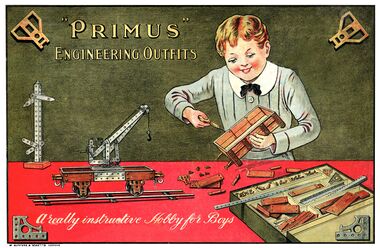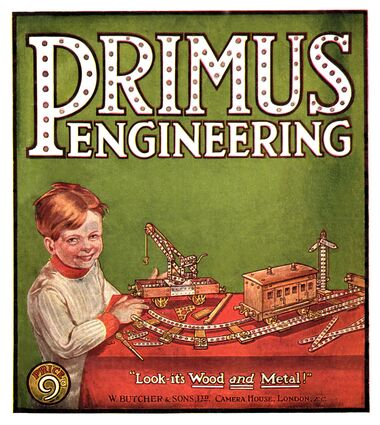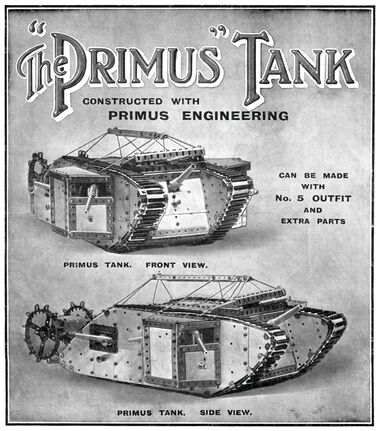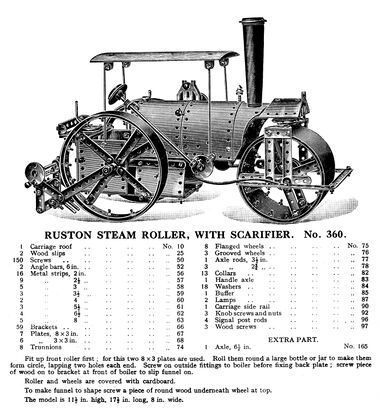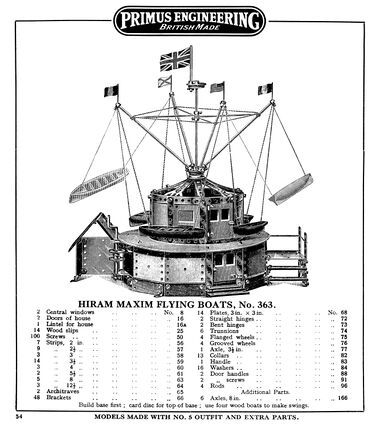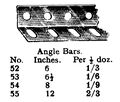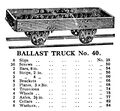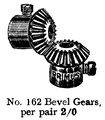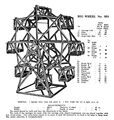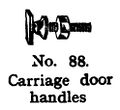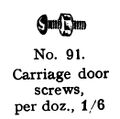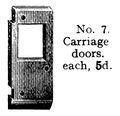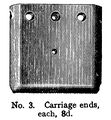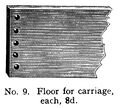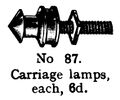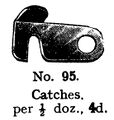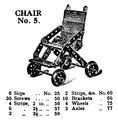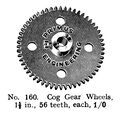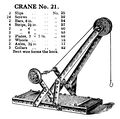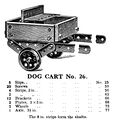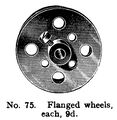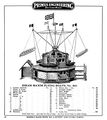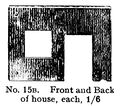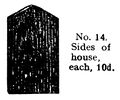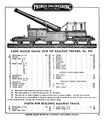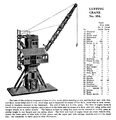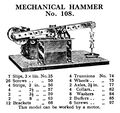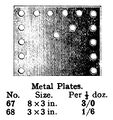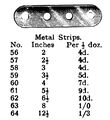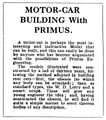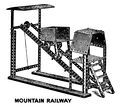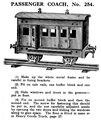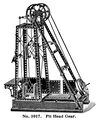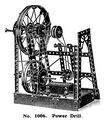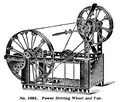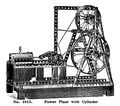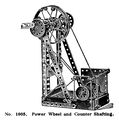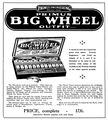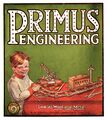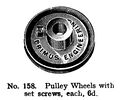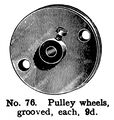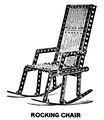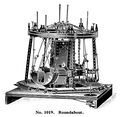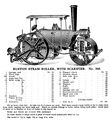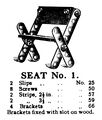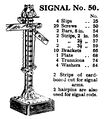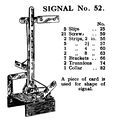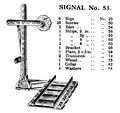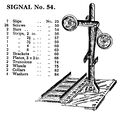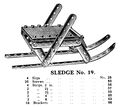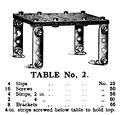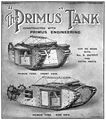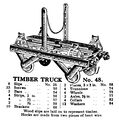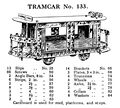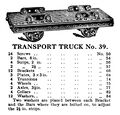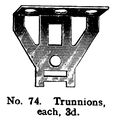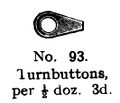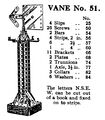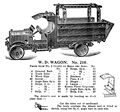Category:Primus Engineering
| Toy Brands and Manufacturers |
|---|
Primus Engineering |
| 1913 - 1923 |
Primus Engineering box label artwork, older [image info]
1923 Primus Engineering instruction manual, front cover artwork [image info]
"The Primus Tank" [image info]
Ruston Steam Roller, with Scarifier [image info]
Hiram Maxim's "Flying Boats" fairground ride (boats not included) [image info]
Primus Engineering (W. Butcher & Sons, London) produced a range of construction toys between 1913 and 1923 that differed from most of the other "Meccano-like", "metal builder" toys in that they included both wooden and metal parts.
The availability of the sets is sometimes listed as ending in 1923, and sometimes 1926. Part of the range appeared in the 1924 Bassett-Lowke Catalogue "B" for 1924, suggesting that perhaps Bassett-Lowke might have bought up the remaining stock.
W. Butcher & Sons
W. Butcher & Sons had its roots in a Nineteenth Century business (under a succession of "Butcher"-related names) that mostly produced camera and camera equipment, and William Frederick Butcher's name appears on a number of patents for camera mechanisms. During WW1, the company could no longer import camera equipment from Germany, and created a joint camera manufacturing business with fellow camera-maker Houghtons in 1915. W. Butcher finally merged with Houghtons in 1926 to form Houghton-Butcher. Shutting down the Primus Engineering construction set range may have been a rationalisation move in advance of creating the new merged camera manufacturing company.
"Wood and metal!"
Although the Primus range included strips and trunnions and wheels similar to those found in Meccano sets, the company tried to differentiate itself from Meccano by not slavishly adhering to the principle that everything in our world could be appropriately modelled using thin metal strips and nuts and bolts.
Primus also included chunky wooden "timbers" with unobtrusive end-holes, as well as wooden blank panels, and panels with windows, allowing the user to make wooden-sided wagons, simple buildings and cabs, and even complete wooden-sided gauge 1 railway carriages (Saloon Carriage No.352) without the result being a distracting mass of metal plates, space holes and protruding screwheads.
To drive this differential home, the company used the box slogan,
- "Look! It's Wood and Metal!".
Primus innovations
While it might be tempting to consider the Primus metal parts to be "knockoffs" of their Meccano counterparts ... and indeed, the simple strips were almost indistinguishable from the Meccano versions ... the relationship between the two companies was a little more complex than this, as Primus sets already included trunnion and architrave parts some years before their equivalents were added to the Meccano range. In this respect it could be argued that the later Meccano Ltd pieces might have been inspired by the Primus versions (although the geometrically-simpler and more abstract Meccano version were possibly more general-purpose and "better" in this regard).
The iconic Meccano trunnion (Meccano Part 126 and 126a) immediately became an important part of the Meccano system, and while the architrave part might seem less significant, Frank Hornby did credit the Meccano architrave as having inspired the Meccano-built prototype of what later became The Hornby Train. Hornby said that the Meccano architrave suggested to him the idea that it might make a useful locomotive cab sidepiece ... but Hornby must have been aware that Primus were using their architrave piece for vehicle side-windows.
The Primus Tank
Primus surprised the toy industry in 1916 by bringing out a large sophisticated model tank almost immediately after the first British military prototypes had been seen in public in ~autumn 1916, later described as being made from the No.5 set "and additional parts".
A little before the real tanks were announced to the British public, almost nobody knew that such things existed, as the development project had been top secret (the reason why tanks are called tanks is because in the early days, those involved with the project had pretended that the large metal boxes that were being built were storage tanks).
Getting their "tank" model into toyshop window displays, where the public could gawp at them, was a considerable public relations coup.
In the Museum
As of August 2016, the "built" Primus models that we have on display consist of a Primus clockwork Locomotive and Goods Truck parked on a length of gauge 1 track in front of a Primus Railway Station. We'd dearly love to expand this with a Primus Passenger Carriage, if anyone out there has one, or has the parts to make one.
External links
Subcategories
This category has the following 10 subcategories, out of 10 total.
B
- Primus Big Wheel Outfit (20 F)
C
M
- Primus Engineering misc models (33 F)
O
- Primus Engineering outfits (2 P, 8 F)
P
- Primus Engineering metal parts (42 F)
R
- Primus Engineering railway models (5 P, 35 F)
W
- Primus Engineering wooden parts (26 F)
Pages in category ‘Primus Engineering’
The following 8 pages are in this category, out of 8 total.
P
Media in category ‘Primus Engineering’
The following 178 files are in this category, out of 178 total.
- All Metal Screwdriver, Primus Part No 101 (PrimusCat 1923-12).jpg 1,788 × 976; 122 KB
- Angle Strips, Primus Part No 52 53 54 55 (PrimusCat 1923-12).jpg 1,875 × 1,601; 347 KB
- Architraves, Primus Part No 65 (PrimusCat 1923-12).jpg 1,941 × 1,449; 417 KB
- Armoured Truck, Primus Model No 261 (PrimusCat 1923-12).jpg 3,000 × 1,808; 1.23 MB
- Automatic Hammer in Shed, Primus Model No 265 (PrimusCat 1923-12).jpg 3,000 × 1,666; 810 KB
- Axles, Primus Part No 77 78 79 165 166 169 (PrimusCat 1923-12).jpg 1,923 × 1,389; 191 KB
- Ballast Truck, Primus Model No 40 (PrimusCat 1923-12).jpg 3,000 × 2,777; 1.16 MB
- Bandstand, Primus model (PrimusCat 1923-12).jpg 2,157 × 3,000; 1.08 MB
- Bent Hinges, Primus Part No 73 (PrimusCat 1923-12).jpg 2,020 × 923; 127 KB
- Bevel Gears, Primus Part No 162 (PrimusCat 1923-12).jpg 1,416 × 1,616; 242 KB
- Big Wheel, Primus Model No 353 (PrimusCat 1923-12).jpg 2,852 × 3,000; 1.44 MB
- Boys Scooter Cart, Primus Model No 1010 (PrimusCat 1923-12).jpg 3,000 × 2,396; 782 KB
- Brackets, Primus Part No 66 (PrimusCat 1923-12).jpg 1,822 × 766; 110 KB
- Buffer Blocks, Primus Part No 4 (PrimusCat 1923-12).jpg 1,789 × 917; 260 KB
- Buffer, Primus Part No 85 (PrimusCat 1923-12).jpg 1,721 × 885; 160 KB
- Bungalow, Primus Model 300 (PrimusCat 1923-12).jpg 3,000 × 1,616; 997 KB
- Cabinet Outfit No6, Primus Engineering (PrimusCat 1923-12).jpg 3,000 × 1,635; 898 KB
- Carriage Door Handles, Primus Part No 88 (PrimusCat 1923-12).jpg 992 × 909; 76 KB
- Carriage Door Screws, Primus Part No 91 (PrimusCat 1923-12).jpg 1,046 × 1,034; 89 KB
- Carriage Doors, Primus Part No 7 (PrimusCat 1923-12).jpg 1,333 × 1,288; 216 KB
- Carriage Ends, Primus Part No 3 (PrimusCat 1923-12).jpg 1,765 × 1,909; 723 KB
- Carriage Floor, Primus Part No 9 (PrimusCat 1923-12).jpg 1,753 × 1,573; 563 KB
- Carriage Lamps, Primus Part No 87 (PrimusCat 1923-12).jpg 1,171 × 973; 110 KB
- Carriage Rails, Primus Part No 90 (PrimusCat 1923-12).jpg 1,542 × 942; 109 KB
- Carriage Roof, Primus Part No 10 (PrimusCat 1923-12).jpg 1,671 × 1,421; 447 KB
- Carriage Window Left-Hand, Primus Part No 6 (PrimusCat 1923-12).jpg 1,565 × 1,297; 331 KB
- Carriage Window Right-Hand, Primus Part No 5 (PrimusCat 1923-12).jpg 1,625 × 1,317; 318 KB
- Carrier Tricycle, Primus Model No 131 (PrimusCat 1923-12).jpg 3,000 × 1,258; 464 KB
- Catches, Primus Part No 95 (PrimusCat 1923-12).jpg 1,104 × 1,165; 149 KB
- Centre Windows, Primus Part No 8 (PrimusCat 1923-12).jpg 1,681 × 1,293; 224 KB
- Chair, Primus Model No 4 (PrimusCat 1923-12).jpg 2,027 × 3,000; 421 KB
- Chair, Primus Model No 5 (PrimusCat 1923-12).jpg 2,960 × 3,000; 644 KB
- Chinese Luggage Barrow, Primus Model 1004 (PrimusCat 1923-12).jpg 3,000 × 2,216; 966 KB
- Coal Truck, Primus model (PrimusCat 1923-12).jpg 2,981 × 1,888; 952 KB
- Cog Gear Wheels, Primus Part No 170 (PrimusCat 1923-12).jpg 2,090 × 1,970; 772 KB
- Collars and Screws, Primus Part No 82 (PrimusCat 1923-12).jpg 1,488 × 988; 119 KB
- Cord, Primus Part No 102 (PrimusCat 1923-12).jpg 1,725 × 383; 57 KB
- Coupling Hook, Primus Part No 86 (PrimusCat 1923-12).jpg 1,844 × 1,429; 229 KB
- Covered Bridge, Primus Model No 305 (PrimusCat 1923-12).jpg 3,000 × 1,398; 647 KB
- Crane on Wheels, Primus Model No 190 (PrimusCat 1923-12).jpg 3,000 × 1,717; 654 KB
- Crane Truck, Primus Model No 315 (PrimusCat 1923-12).jpg 3,000 × 1,383; 695 KB
- Crane Truck, Primus No 189 (PrimusCat 1923-12).jpg 2,348 × 3,000; 844 KB
- Crane, Primus Model No 21 (PrimusCat 1923-12).jpg 3,000 × 2,986; 1.05 MB
- Crank Arm, Primus Part No 164 (PrimusCat 1923-12).jpg 2,757 × 1,109; 342 KB
- Dog Cart, Primus Model 1000 (PrimusCat 1923-12).jpg 3,000 × 1,746; 727 KB
- Dog Cart, Primus Model No 26 (PrimusCat 1923-12).jpg 2,894 × 3,000; 1.02 MB
- Door Lintels, Primus Part No 16A (PrimusCat 1923-12).jpg 1,309 × 945; 148 KB
- Door, Primus Part No 16 (PrimusCat 1923-12).jpg 1,633 × 1,277; 366 KB
- Double Bar Performers, Primus Model No 206 (PrimusCat 1923-12).jpg 3,000 × 1,541; 670 KB
- Double Brake Van, Primus Model No 256 (PrimusCat 1923-12).jpg 3,000 × 1,658; 932 KB
- Double-Tapped Collar, Primus Part No 168 (PrimusCat 1923-12).jpg 1,955 × 664; 128 KB
- Double-Tapped Rods, Primus Part No 167 167a (PrimusCat 1923-12).jpg 2,439 × 951; 189 KB
- Eaves, Primus Part No 71 (PrimusCat 1923-12).jpg 2,049 × 1,337; 475 KB
- Eccentric, Primus Part No 163 (PrimusCat 1923-12).jpg 2,382 × 1,008; 369 KB
- Engine with Double Oscillating Cylinders, Primus Model 1014 (PrimusCat 1923-12).jpg 3,000 × 2,382; 1.19 MB
- Express Coal Truck on Bogies, Primus Model No 259 (PrimusCat 1923-12).jpg 3,000 × 1,704; 897 KB
- Express Truck on Bogies, Primus Model No 258 (PrimusCat 1923-12).jpg 3,000 × 1,698; 1,023 KB
- Farman Biplane, Primus Model No 350 (PrimusCat 1923-12).jpg 3,000 × 2,265; 997 KB
- Fire Escape, Primus Model No 207 (PrimusCat 1923-12).jpg 3,000 × 1,345; 605 KB
- Flanged Wheels, Primus Part No 75 (PrimusCat 1923-12).jpg 1,756 × 1,805; 453 KB
- Footbridge, Primus Model No 107 (PrimusCat 1923-12).jpg 3,000 × 2,052; 717 KB
- Girder Crane, Primus Model No 266 (PrimusCat 1923-12).jpg 3,000 × 2,201; 790 KB
- Grooved Side Rail for Carriage or Truck, Primus Part No 1 (PrimusCat 1923-12).jpg 1,825 × 1,133; 299 KB
- Grooved Side Rail with Footboard, Primus Part No 2 (PrimusCat 1923-12).jpg 1,873 × 1,037; 286 KB
- Handle Axles, Primus Part No 83 (PrimusCat 1923-12).jpg 1,904 × 945; 108 KB
- Hiram Maxim Flying Boats, Primus Model 363 (PrimusCat 1923-12).jpg 2,667 × 3,000; 1.05 MB
- House Baseboard, Primus Part No 19 (PrimusCat 1923-12).jpg 1,733 × 1,120; 291 KB
- House Boat, Primus Model No 308 (PrimusCat 1923-12).jpg 3,000 × 1,961; 639 KB
- House End and Side Rails, Primus Part No 12 13 (PrimusCat 1923-12).jpg 1,828 × 1,216; 238 KB
- House Front and Back, Primus Part No 15B (PrimusCat 1923-12).jpg 1,773 × 1,573; 473 KB
- House Sides, Primus Part No 14 (PrimusCat 1923-12).jpg 1,597 × 1,331; 179 KB
- Island Station, Primus Model No 183 (PrimusCat 1923-12).jpg 3,000 × 1,713; 656 KB
- Knobscrew, Primus Part No 92 (PrimusCat 1923-12).jpg 1,689 × 901; 131 KB
- Lighthouse, Primus Model No 1018 (PrimusCat 1923-12).jpg 1,923 × 3,000; 704 KB
- Long Range Naval Gun on Railway Trucks, Primus Model No 270 (PrimusCat 1923-12).jpg 2,625 × 3,000; 1.08 MB
- Luffing Crane, Primus Model No 354 (PrimusCat 1923-12).jpg 2,894 × 3,000; 1.08 MB
- Mechanical Hammer, Primus Model No 108 (PrimusCat 1923-12).jpg 3,000 × 2,828; 1.03 MB
- Metal Plates, Primus Part No 67 68 (PrimusCat 1923-12).jpg 1,786 × 1,890; 587 KB
- Metal Strips, Primus Part No 56 57 58 59 60 61 62 63 64 (PrimusCat 1923-12).jpg 1,928 × 2,109; 383 KB
- Midland Locomotive 4-4-0 type, Primus Model No 1020 (PrimusCat 1923-12).jpg 3,000 × 1,793; 1.03 MB
- Motor Car and Garage, Primus Model 311 (PrimusCat 1923-12).jpg 3,000 × 1,397; 827 KB
- Motor Car Building With Primus (PrimusCat 1923-12).jpg 1,419 × 1,600; 358 KB
- Motor Car Chassis, Primus Model No 209 (PrimusCat 1923-12).jpg 3,000 × 2,485; 1.16 MB
- Motor Reaping Machine, Primus Model 1015 (PrimusCat 1923-12).jpg 3,000 × 1,956; 1.25 MB
- Motor Transport Truck, Primus model (PrimusCat 1923-12).jpg 3,000 × 2,077; 1.02 MB
- Motor Transport Wagon, Primus Model No 202 (PrimusCat 1923-12).jpg 3,000 × 1,251; 670 KB
- Motor Van, Primus Model No 132 (PrimusCat 1923-12).jpg 2,412 × 3,000; 1.15 MB
- Mountain Railway, Primus model (PrimusCat 1923-12).jpg 3,000 × 2,642; 1,015 KB
- Music Stand, Primus Model No 8 (PrimusCat 1923-12).jpg 2,361 × 2,873; 408 KB
- Nuts and Bolts, Primus Part No 51 50 (PrimusCat 1923-12).jpg 1,807 × 821; 123 KB
- Overhead Travelling Hoist, Primus Model 355 (PrimusCat 1923-12).jpg 3,000 × 1,788; 781 KB
- Overhead Travelling Truck (PrimusCat 1923-12).jpg 3,000 × 1,247; 499 KB
- Passenger Coach, Primus Model No 254 (PrimusCat 1923-12).jpg 2,517 × 3,000; 1.27 MB
- Pinion Wheels, Primus Part No 161 (PrimusCat 1923-12).jpg 1,552 × 1,249; 196 KB
- Pit Head Gear, Primus Model No 1017 (PrimusCat 1923-12).jpg 2,508 × 3,000; 1.04 MB
- Pit Headgear, Primus Part Model No 203 (PrimusCat 1923-12).jpg 3,000 × 1,664; 654 KB
- Platform Centre, Primus Part No 23 (PrimusCat 1923-12).jpg 1,361 × 1,020; 239 KB
- Platform Sides, Primus Part No 24 (PrimusCat 1923-12).jpg 1,337 × 1,057; 227 KB
- Power Drill, Primus Model No 1006 (PrimusCat 1923-12).jpg 2,640 × 3,000; 1.18 MB
- Power Driving Wheel and Fan, Primus Model 1003 (PrimusCat 1923-12).jpg 3,000 × 2,560; 1.32 MB
- Power Plant with Cylinder, Primus Model 1013 (PrimusCat 1923-12).jpg 3,000 × 2,653; 1.35 MB
- Power Wheel and Counter Shafting, Primus Model 1005 (PrimusCat 1923-12).jpg 2,977 × 3,000; 1.03 MB
- Primus Big Wheel Outfit (BL-B 1924-10).jpg 2,737 × 1,149; 330 KB
- Primus Big Wheel Outfit (PrimusCat 1923-12).jpg 2,706 × 3,000; 1.18 MB
- Primus Big Wheel Outfit, lineart (PrimusCat 1923-12).jpg 3,000 × 2,466; 1.33 MB
- Primus Clockwork Locomotive (BL-B 1924-10).jpg 2,841 × 1,729; 506 KB
- Primus Engineering Standard Outfits (BL-B 1924-10).jpg 1,463 × 2,127; 468 KB
- Primus Engineering, box label, older.jpg 3,000 × 1,957; 1.87 MB
- Primus Engineering, instruction manual front cover (PrimusCat 1923-12).jpg 2,681 × 3,000; 1.63 MB
- Primus Engineering, logo (1923).jpg 1,800 × 369; 103 KB
- Primus Motor Chassis Outfit (BL-B 1924-10).jpg 2,815 × 1,531; 461 KB
- Pulley Wheels with set screws, Primus Part No 158 (PrimusCat 1923-12).jpg 2,081 × 1,740; 437 KB
- Pulley Wheels, Primus Part No 159 (PrimusCat 1923-12).jpg 2,015 × 1,334; 427 KB
- Pulley Wheels, Primus Part No 76 (PrimusCat 1923-12).jpg 1,641 × 1,729; 503 KB
- Railing Posts, Primus Part No 11 (PrimusCat 1923-12).jpg 1,282 × 862; 127 KB
- Realistic Railway Track, Primus Model No 205 (PrimusCat 1923-12).jpg 3,000 × 1,058; 448 KB
- Ridge Tiles, Primus Part No 69 70 (PrimusCat 1923-12).jpg 2,025 × 1,447; 300 KB
- Rocking Chair, Primus model (PrimusCat 1923-12).jpg 2,590 × 3,000; 757 KB
- Roundabout, Primus Model No 1019 (PrimusCat 1923-12).jpg 3,000 × 2,937; 1.33 MB
- Roundabout, Primus Model No 198 (PrimusCat 1923-12).jpg 3,000 × 1,337; 755 KB
- Ruston Steam Roller, with Scarifier, Primus Model No 360 (PrimusCat 1923-12).jpg 2,786 × 3,000; 1.25 MB
- Saloon Carriage, Primus Model 352 (PrimusCat 1923-12).jpg 3,000 × 1,826; 982 KB
- Scooter, Primus Model No 1007 (PrimusCat 1923-12).jpg 3,000 × 2,305; 405 KB
- Seat, Primus Model No 1 (PrimusCat 1923-12).jpg 2,351 × 2,760; 425 KB
- Seat, Primus Model No 3 (PrimusCat 1923-12).jpg 2,123 × 3,000; 558 KB
- Side Station, Primus Model No 180 (PrimusCat 1923-12).jpg 3,000 × 1,723; 709 KB
- Signal Gantry, Primus model (PrimusCat 1923-12).jpg 1,786 × 3,000; 764 KB
- Signal Post Rods, Primus Part No 96 (PrimusCat 1923-12).jpg 1,765 × 729; 97 KB
- Signal, Primus Model No 50 (PrimusCat 1923-12).jpg 2,639 × 3,000; 698 KB
- Signal, Primus Model No 52 (PrimusCat 1923-12).jpg 2,847 × 3,000; 632 KB
- Signal, Primus Model No 53 (PrimusCat 1923-12).jpg 3,000 × 2,837; 650 KB
- Signal, Primus Model No 54 (PrimusCat 1923-12).jpg 3,000 × 2,847; 896 KB
- Single Brake Van, Primus Model No 257 (PrimusCat 1923-12).jpg 3,000 × 1,649; 992 KB
- Six-Inch Quick-Firer Gun, Primus Model No 1011 (PrimusCat 1923-12).jpg 3,000 × 1,849; 577 KB
- Sledge, Primus Model No 19 (PrimusCat 1923-12).jpg 3,000 × 2,681; 969 KB
- Smoking Lounge, Primus Model No 309 (PrimusCat 1923-12).jpg 3,000 × 1,279; 704 KB
- Stamp Hammer, Primus Model No 193 (PrimusCat 1923-12).jpg 3,000 × 1,169; 585 KB
- Station and Station House, Primus Model 306 (PrimusCat 1923-12).jpg 3,000 × 1,198; 637 KB
- Station Shed, Primus model (PrimusCat 1923-12).jpg 3,000 × 1,940; 897 KB
- Station Slope, Primus Part No 22 (PrimusCat 1923-12).jpg 1,799 × 1,392; 474 KB
- Steam Navvy, Primus Model No 208 (PrimusCat 1923-12).jpg 3,000 × 1,677; 589 KB
- Steps, Primus Part No 21 (PrimusCat 1923-12).jpg 1,625 × 1,337; 430 KB
- Straight Hinges, Primus Part No 72 (PrimusCat 1923-12).jpg 1,655 × 853; 140 KB
- Supplementary Outfits, Primus Engineering (PrimusCat 1923-12).jpg 3,000 × 1,531; 809 KB
- Swing, Primus Model No 199 (PrimusCat 1923-12).jpg 2,352 × 3,000; 665 KB
- Table, Primus Model No 2 (PrimusCat 1923-12).jpg 3,000 × 2,864; 640 KB
- The Primus Tank, Primus Engineering (PrimusCat 1923-12).jpg 2,644 × 3,000; 1.59 MB
- The Steering Gear, Primus Engineering motor cars (PrimusCat 1923-12).jpg 3,061 × 1,797; 975 KB
- Timber Truck, Primus Model No 38 (PrimusCat 1923-12).jpg 3,000 × 1,840; 1.05 MB
- Timber Truck, Primus Model No 48 (PrimusCat 1923-12).jpg 2,973 × 3,000; 1,001 KB
- Tipping Truck, Primus Model No 255 (PrimusCat 1923-12).jpg 3,000 × 1,353; 754 KB
- Touring Coupe, Primus Model No 211 (PrimusCat 1923-12).jpg 3,000 × 2,091; 1.2 MB
- Tourist Car, Primus model (PrimusCat 1923-12).jpg 2,991 × 2,328; 793 KB
- Tower Bridge, Primus Model No 365 (PrimusCat 1923-12).jpg 3,000 × 2,428; 902 KB
- Tractor Plough, Primus Model 1001 (PrimusCat 1923-12).jpg 3,000 × 2,288; 1.08 MB
- Tramcar, Primus Model No 133 (PrimusCat 1923-12).jpg 3,000 × 2,691; 937 KB
- Transport Truck, Primus Model No 39 (PrimusCat 1923-12).jpg 3,000 × 2,875; 982 KB
- Transporter Bridge, Primus Model No 262 (PrimusCat 1923-12).jpg 3,000 × 1,978; 884 KB
- Travelling Crane, Primus Model No 134 (PrimusCat 1923-12).jpg 2,042 × 3,000; 729 KB
- Truck Ends, Primus Part No 18 (PrimusCat 1923-12).jpg 1,689 × 1,205; 419 KB
- Truck Sides, Primus Part No 17 (PrimusCat 1923-12).jpg 1,373 × 1,133; 237 KB
- Trunnions, Primus Part No 74 (PrimusCat 1923-12).jpg 1,504 × 1,553; 255 KB
- Turnbuttons, Primus Part No 89 (PrimusCat 1923-12).jpg 913 × 737; 73 KB
- Turnbuttons, Primus Part No 93 (PrimusCat 1923-12).jpg 1,061 × 913; 87 KB
- Vane, Primus Model No 51 (PrimusCat 1923-12).jpg 2,626 × 3,000; 637 KB
- Vertical Saw, Primus Model No 304 (PrimusCat 1923-12).jpg 3,000 × 1,794; 657 KB
- Viaduct Bridge, Primus Model No 268 (PrimusCat 1923-12).jpg 3,000 × 1,997; 1.01 MB
- War Department Wagon, Primus Model No 210 (PrimusCat 1923-12).jpg 3,000 × 2,802; 1.35 MB
- Washers, Primus Part No 84 (PrimusCat 1923-12).jpg 1,214 × 895; 102 KB
- Wheeled Hospital Stretcher, primus Model No 1008 (PrimusCat 1923-12).jpg 3,000 × 2,050; 761 KB
- Windmill, Primus model (PrimusCat 1923-12).jpg 2,282 × 3,000; 775 KB
- Window Sash, Primus Part No 15D (PrimusCat 1923-12).jpg 1,028 × 765; 81 KB
- Windowsills, Primus Part No 15A (PrimusCat 1923-12).jpg 1,304 × 909; 122 KB
- Wire Stays, Primus Part No 154 155 156 (PrimusCat 1923-12).jpg 2,195 × 1,211; 190 KB
- Wood Handled Screwdriver, Primus Part No 100 (PrimusCat 1923-12).jpg 2,204 × 906; 171 KB
- Wood Screws, Primus Part No 97 (PrimusCat 1923-12).jpg 1,322 × 710; 78 KB
- Wood Slips, Primus Part No 25 (PrimusCat 1923-12).jpg 1,753 × 961; 256 KB
- Wood Station House with Metal Roof, Primus Model 302 (PrimusCat 1923-12).jpg 3,000 × 2,025; 1.04 MB

